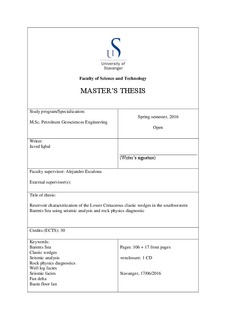| dc.description.abstract | The southwestern Barents Sea is an underexplored area of the Norwegian continental shelf, with a few discoveries in Triassic and Jurassic reservoirs. Recently drilled exploration wells on the Loppa High and the surrounding margins have encountered hydrocarbon bearing clastic wedges in Lower Cretaceous strata. Previous studies have proposed two different depositional environments for these wedges: 1) deep marine fans and, 2) shallow marine transition with tidal influence. Consequently, further studies are required for better understanding of the depositional environment and the reservoir properties of the wedges. This study focusses on reservoir characterization of the Lower Cretaceous clastic wedges along the southern margin of the Loppa High in the Hammerfest Basin. The main objectives of this study are: 1) to define the depositional environment using well logs and seismic data and, 2) to investigate the reservoir properties using rock physics diagnostic. The dataset includes nine wells and four 3D seismic cubes which have been used to define the depositional environment of the wedges.
Ten seismic facies (SF1, SF2 …SF10) have been interpreted on the basis of seismic character and gamma-ray log response. Five types of the wedges (Type 1, Type 2…Type 5) have been identified on the basis of seismic facies whereas Type 1 and 4 also have well logs to support the interpretation. Seismic derived attributes such as variance, chaos and sweetness reveal the lobate shape fan delta (Type 4 wedge) and fan shaped submarine fans (Type 3 and 5 wedges). Sweetness attribute differentiates the fan delta and submarine fans based on their sand and shale content which further delimit these depositional bodies.
Depending upon the location of the wedges in the basin, the depositional environment ranges from transitional shallow marine to deep marine. The shallow marine environments include coastal/delta plain, fan delta, land slope aprons, and shelf canyons which are restricted to the narrow shelf (Type 1, 2 and 4 wedges). Whereas, submarine fans and slope fans (Type 3 and 5 wedges) are dominant in deep marine environments.
Finally, rock physics analysis gives the reservoir properties from depositional (sorting) and diagenesis (cementation) points of view. Type 4 wedges (SF1 and SF4) on the narrow shelf are cemented and have porosity reduction mainly due to cementation and compaction (diagenesis effects). On the other hand, Type 1 wedges (SF2, SF3 and SF5) are not cemented and reduction in porosity is mainly due to deteriorating sorting of the grains (depositional effects). The role of diagenesis increases moving from the east to the west along the margin of the Hammerfest Basin. Therefore, the wedges on the western side have a potential of being good quality reservoirs because of porosity preservation due to cementation and well sorting of the grains. | nb_NO |
